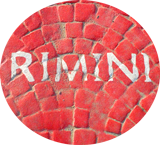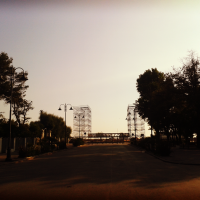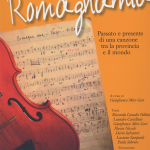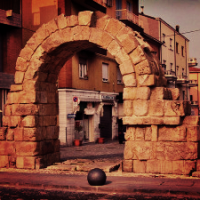Francesca Da Rimini (Francesca da Polenta)
Francesca da Polenta, the daughter of Guido I, has the distinction of being both a famous real-life character associated with Rimini, and at the same time a character in works ranging from Dante through to Rachmaninov and D’Annunzio.
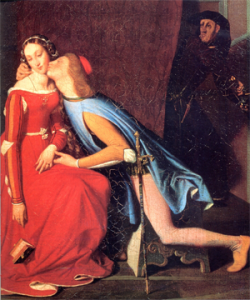
The young Francesca, at the age of 15 or 16, was offered in marriage by her father, the ruling lord of Ravenna, to Giovanni Malatesta of Rimini to cement a strategic alliance. Both the Malatesta and Da Polenta families had profitted from the Guelf Ghibelline conflict to drive out rivals and assume power in Rimini and Ravenna respectively (between 1265 and 1275, at a time when the conflict between Empire and Papacy fuelled conflict throughout Italy).
What happened after her marriage to Giovanni remains shrouded in mystery. We know that the couple had a child, Concordia (named after Giovanni’s mother), and that almost certainly Francesca was murdered around 1285 along with her brother-in-law Paolo Malatesta, at the hands of her jealous husband.
The couple became, within the space of a century after their death, celebrated as symbols of tragic romantic love. Their story became emblematic, thanks to the intervention of writers like Dante and later Bocaccio, constructing a narrative that has become a folk memory, but historians have been endlessly fascinated by the holes and assumptions in the stories that have been handed down about these lovers. Why, for example, did this particular murder become so famous? During the middle ages, while not officially sanctioned, it wasn’t uncommon for betrayed husbands to murder,generally without any serious punishment.
Dante, Francesca, and the Divine Comedy
Fifteen years after their death Dante Alighieri placed the lovers in the inferno of his Divine Comedy. They are there naturally as adulterous lovers, but there is little doubt that the portrayal of Francesca and Paolo is a sympathetic one – the poet allows Francesca to speak, and is moved to tears by her story. His sympathy is all the more striking as it is clear that she has not repented and is still in love with Paolo:
100 Love, that on gentle heart doth swiftly seize,
101 Seized this man for the person beautiful
102 That was ta’en from me, and still the mode offends me.103 Love, that exempts no one beloved from loving,
104 Seized me with pleasure of this man so strongly,
105 That, as thou seest, it doth not yet desert me;
[the longfellow edition]
Francesca is one seen as seized by love, something Dante could sympathise with, and so her culpability in the serious charge of adultery is mitigated, at least for the poet. Dante’s sympathetic portrait of Francesca is often credited as being one of the reasons for which he was given refuge in Ravenna towards the end of his life. Dante had previously visited Ravenna and had dedicated his work on the death of Emporor Henry VII to Guido Novello (the nephew of Francesca’s brother Lamberto). Francesca’s father, Guido I, is also included in the Divine Comedy in a favourable light.
There’s speculation as well that Dante may have personally met Paolo Malatesta. Malatesta certainly spent time in Florence 1282 when he was capitano del populo. What’s certain is that Dante was a poet, not a neutral observer.
Bocaccio sets the scene, switching Giovanni with Paolo
In the late 1360s and early 1370s, fifty years after his death, Florence started to publicly commemorate its most famous poet, with Bocaccio giving public commentaries on the Divine Comedy up to his death in 1375. Amongst these commentaries is a lengthy passage on Paolo and Francesca, written almost a hundred years after their murder, which fills in the background of the story, though with what degree of poetic licence it’s hard to determine.
For Bocaccio, Dante, whilst showing sympathy, was excessively harsh with the young lovers, in particular with Francesca, because according to his telling of the tale the young woman had been tricked into marriage!
The story he recounts suggests that the Malatesta, eager for a strategic alliance, had decided upon a marriage between Giovanni and Francesca. The only problem? Francesca was a beautiful and sensitive young woman, whilst Giovanni – nicknamed Gianciotto, a corruption of Giovanni lo Sciancato, or Giovanni the lame due to a birth defect – was an ugly brutish soldier skilled in the arts of war but hardly worth the affections of such a beauty. The Malatestas, famed even at this stage for their ruthlessnes and cunning hatched a plan to send Paolo, known even in official documents from the time as bello or handsome, to act as a decoy. Francesca thus fell in love with Paolo and was led to believe that she was marrying him, only to find herself with his ugly older brother. The young woman then, in Bocaccio’s version stayed true to her love. Her continuing relationship with Paolo was discovered, and in a dramatic scene Giovanni surprises the two lovers and rushing to strike down his duplicitous brother stabs by accident Francesca.
It’s a version full of drama, tension, and a whole host of poetic devices – Paolo is pointed out ambiguosly to Francesca as her future husband from a spyhole by a deceitful handmaid, or the trick is realised only in the morning light when Francesca sees Giovanni by her side. It’s an interesting and romantic vision that has largely survived into other artworks – all the way to the numerous portraits of the lovers together being surprised by a deformed Giovanni who limps out from behind a curtain, dagger in hand.
It is, though, a work that while perhaps based on fact has little documentation to support it thoroughly, and is very obviously a work with poetic purpose.
Where did Francesca da Rimini’s murder take place?
This is, perhaps, the most heated question debated by scholars of the story – and it’s far from academic, if you think about the millions of visitors who travel to Verona, for example, to see the Juliette’s fictitious balcony. It is also, ironically, a source of local pride and contention between the competing locations.
The main theories suggest the location was either Rimini, Gradara, or Santarcangelo di Romagna, complicated by the fact that there is virtually no contemporary documentation relating to the murder (it’s suggested that both the Malatesta and da Polenta families invoked a sort of omerta on the event, in order to maintain their important strategic alliance).
Gradara, without doubt, is the best looking location for the murder to have taken place. A foreboding looking castle that dominates the countryside around it lying between Rimini and Pesaro. The murder is dated by historians generally to in and around 1285, coinciding with a detail from Bocaccio which suggests that Giovanni was occupying a post away from home, which allowed the lovers a space for the intimacy which would be their downfall. Giovanni in 1285 was Podestà in Pesaro, a position which was temporary and did not allow for the transferral of his family. Following Bocaccio’s account then, Giovanni informed of the betrayal sped home to catch the lovers red-handed. Gradara is a hop, skip, and a jump from Pesaro.
There are, though, some serious problems with the theory of Gradara as the location. First is the fact that, though the castle had been handed over to the Malatesta by this period, the impressive fortifications that make the castle seem so stately were actually erected in the XIII and XIV centuries. Giovanni Malatesta was very much lord of Rimini, and there’s no particular evidence to suggest he would have moved his court to Gradara at the period of the murders.
There is a theory, proposed by Monsignor
Marino Marini that the murders took place in Santarcangelo di Romagna, based in the idea that the murders took place in the late 1280s, and that the Malatestas had fought during this period with their Romagnolo neighbours and had taken possesion of the town’s fortress. There’s precious little else, though, to suggest that the murder took place here – and it seems more a tradition based on the fact that Francesca’s daughter, Concordia, entered a closed convent in Santarcangelo after the death of her murdered mother. Local folklore though doesn’t require much to lay claim to the doomed lovers, and there’s a tradition that the ghost of Francesca wanders the streets of Santarcangelo lamenting her doomed love.
There are variuos theories that suggest different locations in Rimini for the murder. From a house locally described as the house of julius caesar, in Piazza Tre Martiri, through to the Borgo san Andrea. Many scholars, though, presume based on the evidence that exists that the murder took place in the Gattolo di San Colomba, the Palazzo on the site of the later Rocca Malatestiana Castel Sismondo.
There are a number of pointers to the idea that the murder took place in Rimini. First of all there’s the title of the good lady herself – all are agreed she is Francesca da Rimini, as it was in Rimini that she lived (and was buried, apparently). Bocaccio, on whom supporters of the Gradara theory rely heavily speaks of Giovanni rushing back to Rimini to catch the lovers. Nearly all the commentators in the century and a half after the event all seem to tacitly agree that the murder took place in Rimini, and in the absence of proof to the contrary it seems reasonable to accept.
A local historian, Luigi Tonini, at the turn of the 20th century quoted extensively from a discovered document written in the town in the 1580s that suggested, with much excitement, that the couple of Francesca and Paolo had been discovered, in a perfect state of preservation, in a marble tomb in Rimini’s San Augustino church. Aside from this document there seems to be no indication to the couple’s burial, although all the sources confirm that, unusually, the adulterous couple were buried together.
Francesca da Rimini in art
Thanks to the mystery surrounding the tragic couple, and Dante’s evocative portrait, Francesca and Paolo have been the subject of numerous adaptations and artistic representations over the centuries. Aside from commentaries and illustrations from Dante, by the likes of Bocaccio, William Blake, and Gustave Doré, artists like Anselm Feuerbach, Joseph Anton Koch,Mosè Bianchi, and Francesco Scaramuzza have all tackled the scene.
In the 1870s Piotr Tchaikovsky wrote the symphony Francesca da Rimini in Wagner’s home town of Bayreuth – it was written after Tchaikovsky had seen Wagner’s Ring Cycle for the first time. It’s the first of a series of themes on tragic love that Tchaikovsky would approach, famously including Swan Lake and the Romeo and Juliet fantasy overture. The piece lasts about 25 minutes and is noted for the possible influence of Liszt in its composition. Pop psychologists will draw conclusions between the theme of Francesca and Paolo and Tchaikovsky’s complicated sexual identity – he claimed to have loved only one woman in his life, one who was not his wife, and according to various private letters unearthed by musicologists may have been in fact homosexual.
In 1906 Sergei Rachmaninoff completed a two-act opera Francesca da Rimini with a libretto by Modest Ilyich Tchaikovsky, brother of the famous composer.

Pescara born Italian Poet Gabrielle D’Annunzio took on the story for a play which was roundly slated by critics on its Rome debut. The New York Times wrote of it:
“The bare, meagre facts the poet supplemented with long poetical declamations which were intended to take the place of tradition, and, at the same time, to produce the illusion of reality. The result was inevitable. History and romance became irrevocably divorced, and the Roman audience was nauseated by actions that could arouse no artistic emotion, while the poetry, even with its aesthetic excellencies of rhetoric, could not be appreciated because of the unresponsibe setting. […] the comment of one Roman critic:’Signor d’Annunzio has given us nothing but blood and words.'”
The play was five hours long(!) and filled with various blood curdling scenes. Notwithstanding, it was turned into an Opera later by Riccardo Zandonai.
Francesca da Rimini international conference
As we hope to have demonstrated here, the story of Francesca da Polenta, later Francesca da Rimini is one that fascinates both artists and academics. In recognition of the strength of interest in her story, and because it’s a useful entry point into other themes such as the role and rights of women in the medieval court, the influence of the courtly love tradition on European literature etc, Rimini now hosts an annual conference dedicated to ‘Francesca da Rimini studies’ which attracts scholars from leading institutions worldwide.
Recent papers given, for example, have included ‘Francesca ‘love’ and ‘Peace’ – from Dante to d’Annunzio’, ‘Cinematic representations of sexual violence against women’, and ‘Francesca and Eleanora in America between puritanism and the suffragetes’.
The conference, which is open to the public, grows in size and diversity each year and takes in exhibitions, walking tours, and special presentations.
